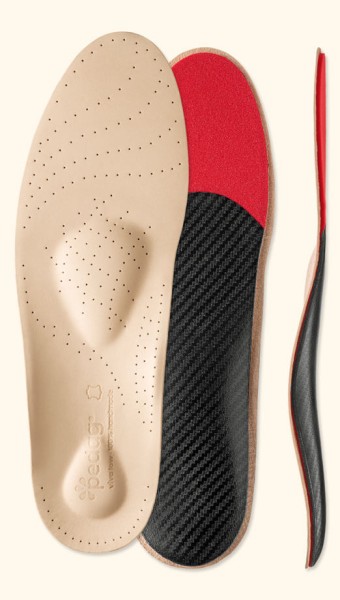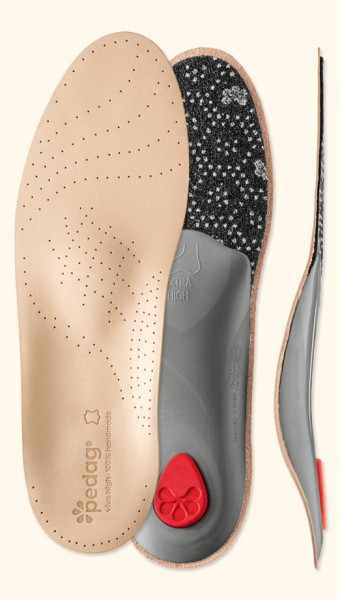More and more often, we are asked to what extent pedag® foot supports contribute to adopting an ideal and healthy posture. We asked Dr. Matthias Finkelstein, Orthopaedic Surgeon and Trauma Surgeon, to explain the interrelationships in this blog. Here we summarize:
- What is an ideal body and walking posture?
- The miracle of our posture and locomotor system.
- How footbeds affect posture and motor function.
- How our lifestyle influences posture and motor function.
- How we improve posture and prevent or alleviate ailments
What is an ideal body and walking posture?
Dr. Finkelstein defines an ideal walking position with the following factors:
- When walking, an upright posture with a straight cervical spine and an upright neck
- the heel always touches the ground first and goes into a rolling movement
- the arms swing when walking and move crossed with the legs.
Dr. Finkelstein points out that the rolling motion of the foot, the upright posture and the swinging of the arms is individual and can be (actively) optimized by appropriate training. Insoles and footbeds stabilize the body, are accompanying (passive) means to stabilize the body.
The miracle of the human posture and movement apparatus
Human posture and movement are based on the perfect interaction of skeleton, muscles (active) as well as ligaments, fasciae and joint capsules (passive). All these elements of motor function are equipped with receptors that send their signals to the brain stem via nerve tracts. Together with the sense of balance, the eyes and the skin, they send the gigantic amount of one billion bits per second to the brain stem to control our movements fluidly and safely. (Source: Dr. Oliver Ludwig; from: Baumgartner, Möller, Stinus. Orthopedic shoe technology. 3rd edition. Page 141, C. Maurer-Verlag. 2018)
Our central nervous system controls the postural and locomotor system in two ways:
Top-down regulation: the individual body levels are corrected from top to bottom via the head posture. Who doesn't know the friendly advice to stand up straight combined with the tips 'chin to the chest, shoulders back...' etc.
Bottom-up regulation: this regulation from bottom to top "adjusts the tone of the muscle groups of the lower extremities (note pedag®: feet, lower legs, thighs) to the higher levels (pelvis, trunk, head) ....". (Source: Dr. Oliver Ludwig; from: Baumgartner, Möller, Stinus. Orthopedic shoe technology. 3rd edition. Page 140. c. Maurer-Verlag. 2018)

Fig. Control of the postural and locomotor system. This is done by the central nervous system in two ways:
Top-down via the head posture from top to bottom over the individual body levels.
Bottom-up by impulses to the muscle groups of the feet and lower legs over the individual body levels. Footbeds stimulate via the sole of the foot bottom-up.
(Source: Baumgartner etc. Orthopädieschuhtechnik. 3. Auflage. Seite 141. C. Maurer-Verlag 2018 & Schelchen GmbH/pedag International)
How foot supports affect posture and motor function
Dr. Matthias Finkelstein, Orthopedist & Trauma Surgeon, describes the effect of footbeds on posture and motor function as follows: "The feet form the foundation of the body. Foot malpositions lead to impairment of the foundation and thus generate static changes in the entire body, which lead to additional work of certain muscle groups. This extra work then causes overuse problems characterized by muscle tension and pain.

Fig. pedagram: The foot pressure measurement provides information about the loaded zones on the soles of the feet, the pressure distribution on the sole and which footbed can provide relief. The red-white marker visible centrally in the lower third forms the body center of gravity plumb line. This pedagram shows that the body's center of gravity is clearly too far back: the posture is backward; the heels are disproportionately strained. (Source: pedag International/Schelchen GmbH 2020)
pedag® insoles counteract this foot malformation and thus stabilize the body's base. A footbed is the only passive means to stabilize the body".
Dr. Finkelstein quotes Dr. Oliver Ludwig, a Biologist specializing in posture and movement analysis, refering the bottom-up regulation of the body: "For example, the sensory signals from the soles of the feet can be used to control the tone of the calf, buttock and back thigh muscles (note pedag®: muscle tension). ... It has been shown that increased sensory information in the forefoot area (for example via a retrocapital pad or retrocapital sensomotoric elements) can counteract a forward displacement of the trunk.
(Source: Dr. Oliver Ludwig; from Baumgartner, Möller, Stinus. Orthopedic shoe technology. 3rd edition. Page 140. c. Maurer-Verlag. 2018)

Fig. Levels of posture regulation: The passive and active musculoskeletal system forms the individual posture of a person through the interaction of these four levels:
(a) feet, lower leg, knee, thigh
(b) pelvis
(c) trunk spine
(d) shoulders, neck, head
(Source: Baumgartner, Möller, Stinus. Orthopedic shoe technology. 3rd edition. Page 141 C. Maurer-Verlag 2018)
How our lifestyle influences posture and motor skills
In the first paragraphs, we listed the individual elements of our motor chain of effects. A look at our everyday life shows that our way of life has serious effects on posture and motor function.
Lack of exercise: weakens our muscles, shortens muscle fibers, tendons and fasciae, reduces sensory information processing in the central nervous system as well as the body's own perception.
Predominant sitting: for example, shortens the hip flexor muscles, while the abdominal and gluteal muscles lose strength. The pelvis tilts forward and pulls the lumbar vertebrae forward with it. The body compensates for this through our motor chains of action by raising the upper torso to form a hollow back or hollow round back. In this way, the body compensates for the head position, the head is taken 'in the neck', cramps and hurts. The neck muscles are shortened.
Varifocal glasses: are a wonderful technical development. When sitting in front of a screen for long periods of time (at work or during leisure time), they put additional strain on the neck muscles which are shortened by sitting for long periods of time. Varifocals, designed for orientation in a normal room as well as in front of the door, force me to put my head in the neck when focusing the screen. This shortens and cramps the neck muscles even more.
Already while reading these examples you can feel your own bad posture and feel the need to stretch. And that’s good, as the next paragraph shows.
How we improve posture and prevent or alleviate ailments
As described, human posture and motor function are based on a complex interaction of our entire body with its environment. All too often in everyday life we neglect the fact that the 'locomotor apparatus' derives its name from movement and for good reason is called neither 'sitting apparatus' nor 'chill apparatus'. A little bit of mindfulness helps to improve posture with holistic measures and to prevent or alleviate ailments.
The best day to meet your body’s needs is today. In just 3 simple steps:
1. Footbeds: according to the bottom-up regulation described above, they can have a stimulating effect on the foundation of our feet - thanks to the chain of effects from bottom to top via lower leg, thigh, pelvis, trunk, neck and head ... relaxing the whole body.
pedag® foot supports and insoles are therefore developed in cooperation with orthopaedic consultants and as medical products are produced according to DIN EN ISO 13485.
2. Get enough exercise every day: if you already do sports 3 - 4 times a week, you have an advantage. Those who are deterred by sport can use the healing powers of brisk walking to improve their cardiovascular and motor functions. By the way, climbing stairs is the booster for heart and muscles. Daily stimulation of the muscles tightens the body and improves posture.
pedag® foot supports and insoles are therefore available for every activity, every shoe type and every weather condition. For fashionable shoes as well as for sports, outdoor or work shoes.
3. Stretch: the best prevention against injuries and pain for the entire musculoskeletal system. Stretch muscles, ligaments, tendons, fasciae and joint capsules. Fascial rollers are also ideal for this.
Extra-Tip PC Glasses: anyone who works a lot at the computer screen and regularly suffers from neck and headaches should seek advice on glasses for computer workstations.
What do pedag® users say about their foot supports and insoles?
The following ratings are all from pedag® users in 2020. The pedag® Viva foot supports are among the bestsellers in the pedag® range. They are available in different arch heights, for summer and winter, for fashionable shoes like sports shoes & sneakers. (Source: Amazon 2020)
Rating pedag® Viva Mini: 5-star. Love them, fit in every shoe. 05.04.2020
“I have tried a ton of orthotic inserts. These are the most comfortable and the only ones I have found where the metatarsal pad is in the correct spot for me. They take up little to no room in the shoe and work with everything from ballet flats to boots.”
Rating pedag® Viva: 5-star. Long Lasting Comfort. 05.08.2020
“I've used Pedag inserts in sports and dress shoes for over 10 years. Viva insoles are my go to in controlling planta fasciitis and maintaining all day comfort. While i try others, i always return to Pedag as quality and comfort are tops.”
Rating pedag® Viva High: 5-star. Works as well as my $500 orthotics. 29.07.2020
“Superior arch support for My extra high arch They work just as well as the $500 pair of orthotics I had made at the podiatrist. really.”
Rating pedag® Viva Sport: 5-star. Comfort For Injury. 17.05.2020
“I incurred a metatarsal injury that had me limping in pain for weeks. These insoles immediately eliminated the pain.”
Rating pedag® Viva Sport: 5-star. Supports to where it matters. 05.08.2020
“Great product, supports heel and mid-foot. Not too thick compared to other insoles.”
Rating pedag® Viva Sport: 5-star. An absolute lifesaver. 05.10.2020
“I had been suffering from plantar fasciitis for a while before I got these. The results were borderline miraculous! I’m able to get through a whole day of work while managing the pain with these insoles! I highly recommend them!”




